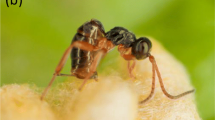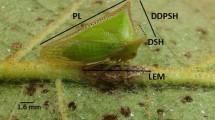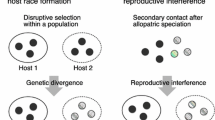Summary
Males of the desert grasshopper Ligurotettix coquilletti typically eclose 3–5 weeks prior to females. Early-eclosed males experience more female encounters than the later-eclosed individuals. Evidence suggests that the number of encounters may be proportional to male lifetime mating success. Early-eclosed males enjoyed greater adult lifespans, occupied and defended higher quality territories (Larrea shrubs), and tended to be dominant on these shrubs if several males were present. The elevated number of female encounters were not conferred on early-eclosed males by their extended survivorship, but rather by the high quality of their territories, which retained numerous females, and their dominant behavior. We evaluate several female-benefit and male-benefit hypotheses for the evolution of protandry and propose that in L. coquilletti, the phenomenon arose due to male-male competition for female-encounter sites, a mechanism not considered in earlier models. Finally, we discuss several reasons for the high variance in the date of male eclosion.
Similar content being viewed by others
References
Baughman JF, Murphy DD, Ehrlich PR (1988) Emergence patterns in male checkerspot butterflies: testing theory in the field. Theor Popul Biol 33:102–113
Bulmer MG (1983) Models for the evolution of protandry in insects. Theor Popul Biol 23:314–322
Chapman RF, Bernays EA, Wyatt T (1988) Chemical aspects of host-plant specificity in three Larrea-feeding grasshoppers. J Chem Ecol 14:561–579
Fagerström T, Wiklund C (1982) Why do males emerge before females? Protandry as a mating strategy in male and female butterflies. Oecologia 52:164–166
Greenfield MD, Shelly TE (1985) Alternative mating strategies in a desert grasshopper: evidence of density-dependence. Anim Behav 33:1192–1210
Greenfield MD, Shelly TE (1990) Territory-based mating systems in desert grasshoppers: effects of host plant distribution and variation. In: RF Chapman, A Joern (eds) Biology of grasshoppers. J Wiley, New York, pp 315–335
Greenfield MD, Shelly TE, Downum KR (1987) Variation in hostplant quality: implications for territoriality in a desert grasshopper. Ecology 68:828–838
Greenfield MD, Shelly TE, Gonzalez-Coloma A (1989) Territory selection in a desert grasshopper: the maximization of conversion efficiency on a chemically defended shrub. J Anim Ecol 58:761–771
Hastings J (1989) Protandry in western cicada killer wasps, (Sphecius grandis, Hymenoptera: Sphecidae): an empirical study of emergence time and mating opportunity. Behav Ecol Sociobiol 25:255–260
Iwasa Y, Odendaal FJ, Murphy DD, Ehrlich PR, Launer AE (1983) Emergence patterns in male butterflies: a hypothesis and a test. Theor Popul Biol 23:363–379
Otte D (1981) The North American grasshoppers. I. Acrididae, Gomphocerinae and Acridinae. Harvard University Press, Cambridge
Otte D, Joern A (1975) Insect territoriality and its evolution: population studies of desert grasshoppers on creosote bushes. J Anim Ecol 44:29–54
Shelly TE, Greenfield MD (1985) Alternative mating strategies in a desert grasshopper: a transitional analysis. Anim Behav 33:1211–1222
Shelly TE, Greenfield MD, Downum KR (1987) Variation in host plant quality: influences on the mating system of a desert grasshopper. Anim Behav 35:1200–1209
Singer MC (1982) Sexual selection for small size in male butterflies. Am Nat 119:440–443
Thornhill R, Alcock J (1983) The evolution of insect mating systems. Harvard University Press, Cambridge
Wang G-y (1990) Ontogeny of a dominion: developmental influences on dominance in a desert grasshopper (Orthoptera: Acrididae). In: Doctoral dissertation. University of California, Los Angeles, USA, pp 91–139
Wiklund C, Fagerström T (1977) Why do males emerge before females? A hypothesis to explain the incidence of protandry in butterflies. Oecologia 31:153–158
Wiklund C, Solbreck C (1982) Adaptive versus incidental explanations for the occurrence of protandry in a butterfly Heptidea sinapis L. Evolution 36:56–62
Author information
Authors and Affiliations
Rights and permissions
About this article
Cite this article
Wang, Gy., Greenfield, M.D. & Shelly, T.E. Inter-male competition for high-quality host-plants: the evolution of protandry in a territorial grasshopper. Behav Ecol Sociobiol 27, 191–198 (1990). https://doi.org/10.1007/BF00180303
Received:
Accepted:
Issue Date:
DOI: https://doi.org/10.1007/BF00180303




